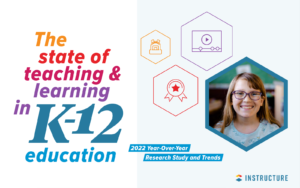Improving Student Engagement With Course Access

By: Neil Campbell
As someone who is lucky to have friends all over the Southeast, Midwest, and Northeast – every week from early August through early September involves a new round of pictures on my Facebook feed with captions to the effect of, “I can’t believe (…) is already in (…) grade!”
These pictures are awesome, from the excited first graders practically bouncing off the page to the teenagers who can’t quite believe summer is over, they’re awake before 7 a.m., and that their parents actually want to commemorate that morning.
My perception of the different levels of excitement for school between teenagers and elementary schoolers on Facebook may be a symptom of my friends’ photographic overreach, but there are serious issues our education system needs to address to make high school engaging and motivating for more students.
Gallup’s 2012 survey of student engagement showed that the longer students stay in school, the less engaged they become. Engagement drops from 76 percent of elementary school students to 61 percent of middle schoolers and 44 percent of high schoolers in their 2012 survey.
Civic Enterprise’s 2006 survey of students who dropped out of high school found that 69 percent were not motivated or inspired to work hard, and 47 percent said that a major reason for dropping out was that classes were not interesting. In other words, many students were dropping out because they weren’t motivated to work, not because courses were too hard.
The Center on Education Policy’s report on student motivation highlighted four major dimensions that researchers generally agree contribute to motivation:
- Competence – Believing in the ability to complete a task;
- Control/Autonomy – Having some influence over whether and how to undertake a task and seeing a link between actions and outcomes;
- Interest/Value – Seeing value in completing a task; and
- Relatedness – Receiving some social reward or approval for completing a task.
Providing students with more control and autonomy over their education by allowing access to a wide range of courses that interest them is why we are so excited about Course Access programs.
No high school on its own is able to offer their students a complete range of career and technical courses leading to in demand certifications, Advanced Placement or early college/dual enrollment courses, foreign languages, and credit recovery or remediation courses to get back on track to graduation. But Course Access programs can help motivate and engage students by enabling them to select whatever courses they want, in the formats they want (e.g. online, face-to-face, or blended), from a range of providers.
Khan Academy just launched a campaign – You Can Learn Anything – that builds off some of this same research on motivation, primarily from Carol Dweck at Stanford. They are emphasizing the importance of a Growth Mindset to understand that intelligence is not a fixed quantity, but rather something that can be grown through effort and practice.
My hope is that next August’s timeline will feature more teenagers excited to be heading back to school, ready to show they can learn anything and work hard in courses they want to take. If they still look unhappy, I’ll just place all the blame on my friends forcing them in front of a camera before 7 a.m.
Neil Campbell is the Policy Director for Personalized and Blended Learning for the Foundation for Excellence in Education. Follow Neil on Twitter @n_m_campbell.






0 Comments
Leave a Comment
Your email address will not be published. All fields are required.